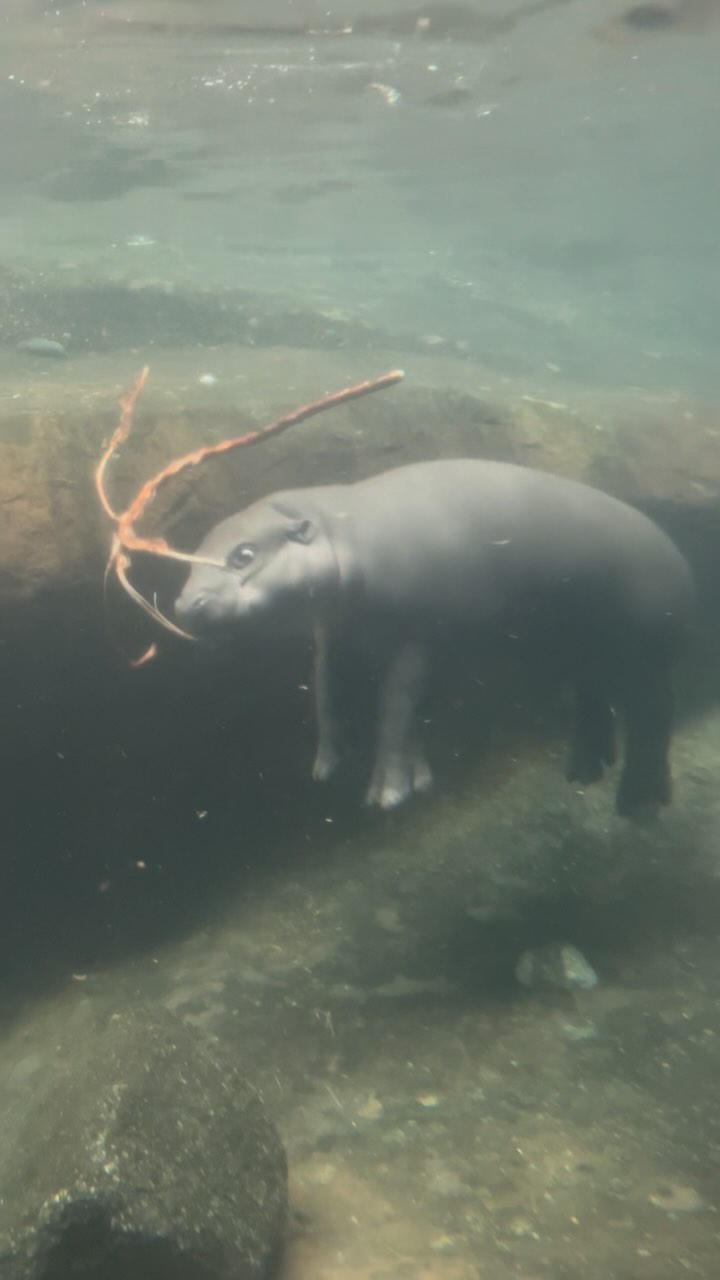- The significance of enrichment items in animal behavior and welfare
- The role of play in the development of young pygmy hippos like Adama
- An overview of pygmy hippopotamus behavioral patterns and habitat needs
- Conservation efforts and challenges facing pygmy hippos in the wild
- How zoos utilize enrichment to foster natural behaviors and enhance animal well-being
Adama, our young pygmy hippopotamus, captivates visitors with her playful interactions with a seemingly simple item: a stick. This interaction might appear trivial, yet it highlights an essential component of modern zoo management—enrichment. Enrichment items like sticks are crucial for promoting natural behavior, contentment, and psychological stimulation in captive animals. These items mimic elements of an animal’s natural environment, encouraging behaviors they would typically display in the wild. For Adama, engaging with a stick involves exploration and play, activities crucial for her physical and mental development.
Enrichment is an integral part of animal welfare, particularly for intelligent, curious species like the pygmy hippo. It creates an environment that stimulates numerous senses, providing opportunities for problem-solving and dexterous activity. Sticks are particularly suitable for animals like Adama; they can be manipulated, chewed, or even used in social play. Such interactions are vital for exercise and honing instincts. These activities are not just about keeping animals occupied. They also play a fundamental role in stress reduction.
Understanding the role of play in animal behavior helps explain why young pygmy hippos such as Adama benefit from enrichment items. Play serves several purposes in the animal kingdom. It contributes to social bonding, cognitive development, and the enhancement of motor skills. In the wild, young animals must learn how to navigate complex social structures and environments. While Adama’s home is crafted to be safe and supportive, enrichment helps simulate challenges she would face in the wild. Interacting with her stick encourages problem-solving and decision-making skills. These skills contribute to her overall well-being.
Pygmy hippos, although sharing a name with the larger common hippos, have distinct behavior patterns. Native to the forests and swamps of West Africa, they are largely solitary animals. Unlike large hippos, they do not rely heavily on social structures. Their semi-aquatic nature requires spending significant time in water, which aids in temperature regulation and buoyancy. In captivity, understanding these habits is key to replicating their natural environment. Adama’s enclosure includes ample water features and foliage, resembling the lush habitats of Sierra Leone and Liberia. Enrichment activities with objects like sticks allow Adama to exhibit her innate behaviors, contributing to her overall health and happiness.
Pygmy hippos face numerous conservation challenges in the wild. Deforestation, human encroachment, and illegal hunting pose significant threats to their survival. The International Union for Conservation of Nature (IUCN) lists them as endangered. Zoos and wildlife reserves are vital for their protection. They offer a sanctuary away from these threats while also playing a crucial role in education and conservation. Every interaction that visitors observe, like Adama’s interactions with her stick, serves as an educational opportunity. It emphasizes the need for conservation and highlights the challenges pygmy hippos face in their natural environments.
In the context of conservation, zoos adopt various strategies to enhance animal well-being and support species preservation. Enrichment forms a significant part of these strategies. By involving young pygmy hippos like Adama in enrichment activities, zoos encourage vital natural behaviors. These actions foster environmental awareness among visitors. When visitors see Adama engaging with her stick, it can inspire curiosity and concern for her species. This translates into wider support for conservation initiatives.
Integrated zoo management practices underscore the importance of providing engaging and realistic habitats for animals. Such environments must replicate the complexities and stimuli of wild spaces. For pygmy hippos, this involves a delicate balance of aquatic and terrestrial features. Enrichment items, including sticks, enrich these carefully crafted environments. These items encourage animals like Adama to remain active and mentally stimulated. They also draw attention to the plight of pygmy hippos in the wild, reinforcing the need for sustained conservation efforts.
In summary, observing Adama, the pygmy hippopotamus, playing with her stick offers insight into effective zoo management and animal welfare. Through strategic enrichment, zoos enable animals to engage in natural behaviors, promoting their health and well-being. These practices not only highlight the sophisticated nature of captive care but also underscore the importance of conservation efforts. By understanding these elements, we gain a greater appreciation for both the challenges and the triumphs of wildlife conservation.
*****
Source Description
It’s with Adama, our pygmy hippopotamus, and her stick! 🦛
Enrichment items, such as sticks, are objects that stimulate an animal’s natural behaviors. For young pygmy hippos like Adama, interacting with sticks encourages exploration and play.


